| Listing 1 - 9 of 9 |
Sort by
|
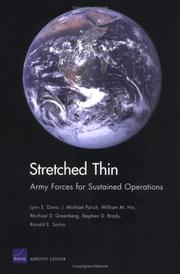
ISBN: 0833038168 0833040898 1601290209 9780833040893 9781601290205 9780833038166 9780833040855 0833040855 Year: 2005 Publisher: Santa Monica, CA : Rand,
Abstract | Keywords | Export | Availability | Bookmark
 Loading...
Loading...Choose an application
- Reference Manager
- EndNote
- RefWorks (Direct export to RefWorks)
Describes the effects of deployments on the Army's ability to provide forces for other contingencies, to ensure that soldiers are trained, and to continue to recruit and retain soldiers. The authors found that Army plans for transformation and employing reserves fall short. Unless requirements recede, the nation faces an Army stretched thin.
United States. Army -- Appropriations and expenditures. --- United States. Army -- Cost control. --- United States. Army -- Personnel management. --- United States. Army -- Recruiting, enlistment, etc. --- Military Administration --- Military & Naval Science --- Law, Politics & Government --- United States. --- Recruiting, enlistment, etc. --- Appropriations and expenditures. --- Personnel management. --- Cost control. --- U.S. Army --- US Army --- E-books
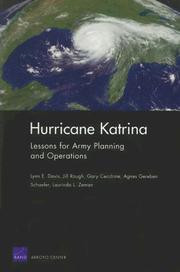
ISBN: 1281181145 9786611181147 0833042742 0833041673 9780833042743 9781281181145 9780833041678 6611181148 Year: 2007 Publisher: Santa Monica, CA : RAND,
Abstract | Keywords | Export | Availability | Bookmark
 Loading...
Loading...Choose an application
- Reference Manager
- EndNote
- RefWorks (Direct export to RefWorks)
The efforts undertaken by civilian and military organizations in response to Hurricane Katrina were historically unprecedented, but problems did arise in the military response that contributed to delays in accomplishing evacuations and relief operations across the storm-ravaged areas of Louisiana and Mississippi, particularly New Orleans. A number of steps can be taken to enhance future military disaster-response efforts: give the National Guard the federal mission to conduct homeland security activities; make each National Guard unit capable of rapid deployment; prepare governors to call up G
Armed forces. --- Disaster relief. --- Electronic books. --- Hurricane Katrina, 2005. --- Military planning. --- Military planning --- Armed Forces --- Hurricane Katrina, 2005 --- Disaster relief --- Military & Naval Science --- Law, Politics & Government --- Military Science - General --- Civic action --- Civic action. --- Disaster assistance --- Emergency assistance in disasters --- Emergency relief --- Katrina, Hurricane, 2005 --- Civic action of Armed Forces --- Military civic action --- Emergency management --- Human services --- Hurricanes --- Civil-military relations
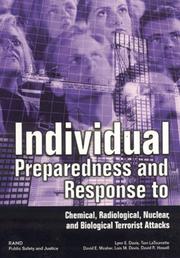
ISBN: 1282451383 9786612451386 0833036084 0833034731 9780833036087 9781282451384 9780833034731 Year: 2003 Publisher: Santa Monica, CA : Rand,
Abstract | Keywords | Export | Availability | Bookmark
 Loading...
Loading...Choose an application
- Reference Manager
- EndNote
- RefWorks (Direct export to RefWorks)
Individual preparedness is an important element of our nation?s strategy for homeland security. This report provides a rigorous way to identify actions individuals can take to protect their health and safety. The authors detail a prospective individual?s strategy across four types of terrorist attacks-chemical, radiological, nuclear, and biological-consisting of overarching goals and simple responses and preparations. The actions are designed to be sensitive to potential variations and defined in terms of simple rules that should be easy for individuals to adopt.
Bioterrorism--Safety measures. --- Chemical terrorism--Safety measures. --- Nuclear terrorism--Safety measures. --- Weapons of mass destruction--Safety measures. --- Weapons of mass destruction --- Nuclear terrorism --- Bioterrorism --- Chemical terrorism --- Survival --- Consumer Participation --- Nuclear Warfare --- Radioactive Hazard Release --- Chemical Warfare --- Disaster Planning --- Disasters --- Terrorism --- Biological Warfare --- War --- Community Health Services --- Accidents --- Consumer Organizations --- Public Health --- Violence --- Health Services --- Organizations --- Social Problems --- Environment --- Crime --- Environment and Public Health --- Sociology --- Health Care Economics and Organizations --- Health Care Facilities, Manpower, and Services --- Social Sciences --- Health Care --- Criminology --- Anthropology, Education, Sociology and Social Phenomena --- Military Science - General --- Military & Naval Science --- Law, Politics & Government --- Safety measures --- Survival. --- Safety measures. --- CBRNEs (Weapons) --- CBRNs (Weapons) --- Chemical, biological, radiological and nuclear weapons --- Mass destruction, Weapons of --- NBC agents (Weapons) --- NBC weapons --- Nuclear, biological and chemical weapons --- WMDs (Weapons) --- Survival after airplane accidents, shipwrecks, etc. --- Survival skills --- Bio-terrorism --- Biological terrorism --- Law and legislation --- Military weapons
Book
ISBN: 9780833086341 0833086340 9780833085887 0833085883 Year: 2014 Publisher: Santa Monica, California : RAND Corporation,
Abstract | Keywords | Export | Availability | Bookmark
 Loading...
Loading...Choose an application
- Reference Manager
- EndNote
- RefWorks (Direct export to RefWorks)
Firearms --- Law and legislation. --- Firearms control --- Gun control --- Right to bear arms --- Right to keep arms --- Safety regulations --- Laws and regulations --- Law and legislation
Book
ISBN: 0833073826 0833073842 0833073400 9780833073822 9780833073846 9780833073402 9780833073846 9780833073839 0833073834 Year: 2012 Publisher: Santa Monica, CA : RAND,
Abstract | Keywords | Export | Availability | Bookmark
 Loading...
Loading...Choose an application
- Reference Manager
- EndNote
- RefWorks (Direct export to RefWorks)
The role of the United States and its global military presence are under debate in the face of changing strategic and economic realities. The authors present a menu of global postures and compare them in terms of the U.S. Air Force bases, combat forces, active-duty personnel, and base operating costs. Ultimately, the choice will depend on perspectives on the role overseas military presence can play in achieving U.S. global security interests.
Military bases, American -- Foreign countries. --- National security -- United States -- Planning. --- United States -- Armed Forces -- Foreign countries. --- United States -- Defenses -- Planning. --- United States -- Military policy -- Planning. --- Military bases, American --- National security --- Strategy --- Military & Naval Science --- Law, Politics & Government --- Armies --- Planning --- Strategy. --- Planning. --- United States --- Armed Forces --- Defenses --- Military policy --- Military strategy --- National security policy --- NSP (National security policy) --- Security policy, National --- American military bases --- Government policy --- U.S.A. --- Jungtinės Amerikos valstybės --- Soedinennye Shtaty Si︠e︡vernoĭ Ameriki --- Soedinennye Shtaty Severnoĭ Ameriki --- Si︠e︡vero-Amerikanskīe Soedinennye Shtaty --- Severo-Amerikanskie Soedinennye Shtaty --- Zlucheni Derz︠h︡avy --- USA --- US --- Arhab --- Ar. ha-B. --- Artsot ha-Berit --- ولايات المتحدة الامريكية --- Wilāyāt al-Muttaḥidah al-Amirīkīyah --- ABSh --- Amerika Birlăshmish Shtatlary --- ABŞ --- Amerika Birlăşmi Ştatları --- Forente stater --- Spojené staty americké --- Severo-Amerikanskie Shtaty --- Sjedinjene Američke Države --- Zʹi︠e︡dnani Derz︠h︡avy Ameryky --- Amerikai Egyesült Államok --- Yhdysvallat --- Verenigde Staten --- Egyesült Államok --- Hiwsisayin Amerikayi Miatsʻeal Tērutʻiwnkʻ --- Estados Unidos de América --- United States of America --- Fareyniḳṭe Shṭaṭn --- Artzois Ha'bris --- Estados Unidos da América do Norte --- SShA --- Soedinennye Shtaty Ameriki --- VSA --- États-Unis d'Amérique --- Vereinigte Staaten von Amerika --- Stati Uniti d'America --- Estados Unidos --- EE.UU. --- Stany Zjednoczone --- ĒPA --- Amerika Qūrama Shtattary --- Amerika Qŭshma Shtatlari --- SAD --- Saharat ʻAmērikā --- Hēnomenai Politeiai Amerikēs --- ZSA --- Mei-kuo --- Meiguo --- Mei guo --- ZDA --- Združene države Amerike --- U.S. --- America (Republic) --- Amirika Carékat --- Verenigde State van Amerika --- VS --- ولايات المتحدة --- Wilāyāt al-Muttaḥidah --- ولايات المتّحدة الأمريكيّة --- Wilāyāt al-Muttaḥidah al-Amrīkīyah --- Estatos Unitos --- Estatos Unitos d'America --- Ètats-Unis d'Amèrica --- Estaos Xuníos d'América --- Estaos Xuníos --- Tetã peteĩ reko Amérikagua --- Istadus Unidus --- Amerika Birlăşmiş Ştatları --- Amerika ka Kelenyalen Jamanaw --- Bí-kok --- Amerika Qushma Shtattary --- AQSh --- Злучаныя Штаты Амерыкі --- Zluchanyi︠a︡ Shtaty Ameryki --- Yunaeted Stet blong Amerika --- Yunaeted Stet --- Vaeinigte Staatn --- Vaeinigte Staatn vo Amerika --- Stadoù-Unanet Amerika --- Sŭedineni amerikanski shtati --- САЩ --- SASht --- Съединените щати --- Sŭedinenite shtati --- Америка (Republic) --- Amerika (Republic) --- Estats Units d'Amèrica --- Америкӑри Пӗрлешӳллӗ Штатсем --- Amerikări Pĕrleshu̇llĕ Shtatsem --- Stati Uniti --- SUA (Stati Uniti d'America) --- Unol Daleithiau America --- Unol Daleithiau --- Amerikas Forenede Stater --- Vereinigte Staaten --- Wááshindoon Bikéyah Ałhidadiidzooígíí --- Zjadnośone staty Ameriki --- Ameerika Ühendriigid --- Ηνωμένες Πολιτείες της Αμερικής --- Hēnōmenes Politeies tēs Amerikēs --- Η.Π.Α. --- Ē.P.A. --- Usono --- Unuiĝintaj Ŝtatoj de Ameriko --- Американь Вейтьсэндявкс Штаттнэ --- Amerikanʹ Veĭtʹsėndi︠a︡vks Shtattnė --- Ameriketako Estatu Batuak --- Feriene Steaten --- Feriene Steaten fan Amearika --- FS --- Stâts Unîts di Americhe --- Stâts Unîts --- Stáit Aontaithe Mheiriceá --- Steatyn Unnaneysit America --- Steatyn Unnaneysit --- S.U.A. --- Na Stàitean Aonaichte --- NSA --- Mî-koet --- 미국 --- Miguk --- Amerikayi Miatsʻyal Nahangner --- Miatsʻyal Nahangner --- Military art and science --- Military doctrine --- Economic policy --- International relations --- Американь Вейтьсэндявкс Штаттнэ --- Spojené obce severoamerické --- États-Unis --- É.-U. --- ÉU
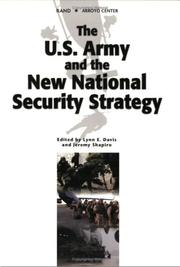
ISBN: 0833034138 0833033476 9780833034137 9780833033475 9780833033475 Year: 2003 Publisher: Santa Monica, CA : RAND,
Abstract | Keywords | Export | Availability | Bookmark
 Loading...
Loading...Choose an application
- Reference Manager
- EndNote
- RefWorks (Direct export to RefWorks)
This book examines the Army's role in the war on terrorism; the Army's homeland security needs; the implications of increased emphasis on Asia; the Army's role in coalition operations; the unfinished business of jointness-the lessons learned from operations and how to prepare for the future; the Army's deployability, logistical, and personnel challenges; and whether the Army can afford its Transformation. These examinations are bracketed by an introduction, a description of the Army's place in the new national security strategy, and a summary of the authors' conclusions.
National security --- World politics --- United States. --- United States --- Military policy. --- Homeland defense --- Homeland security --- U.S. Army --- US Army
Book
ISBN: 9780833051752 083305175X 9786613135865 0833053086 1283135868 9780833053084 9781283135863 Year: 2011 Publisher: Santa Monica, CA : RAND,
Abstract | Keywords | Export | Availability | Bookmark
 Loading...
Loading...Choose an application
- Reference Manager
- EndNote
- RefWorks (Direct export to RefWorks)
As Iran's nuclear program evolves, U.S. decision makers will confront a series of critical policy choices involving complex considerations and policy trade-offs. These policy choices could involve dissuading Iran from developing nuclear weapons; deterring Iran from using its nuclear weapons, if it were to acquire them; and reassuring U.S. regional partners. The U.S. Air Force will need to prepare to carry out whatever policies are chosen.
#SBIB:327.5H22 --- #SBIB:328H515Ontwapeningsproblemen - bewapening --- Instellingen en beleid: Iran --- #SBIB:328H515 --- Ontwapeningsproblemen - bewapening --- Iran -- Strategic aspects. --- Nuclear arms control -- Iran. --- United States -- Military policy. --- Nuclear arms control --- Nuclear weapons --- Iran --- United States --- Foreign relations --- Strategic aspects. --- Military policy. --- Nuclear weapons control --- Arms control --- República Islâmica do Irã --- Irã --- Persia --- Northern Tier --- Islamic Republic of Iran --- Jumhūrī-i Islāmī-i Īrān --- I-lang --- Paras-Iran --- Paras --- Persia-Iran --- I.R.A. --- Islamische Republik Iran --- Islamskai︠a︡ Respublika Iran --- I.R.I. --- IRI --- ايران --- جمهورى اسلامى ايران --- Êran --- Komarî Îslamî Êran
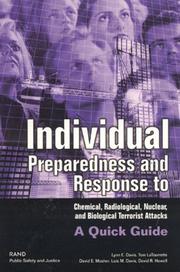
ISBN: 1282451472 9786612451478 0833036076 0833034871 9780833036070 9780833034878 1282940449 9786612940446 0833050362 9780833050366 Year: 2003 Publisher: Santa Monica, CA : RAND Public Safety and Justice,
Abstract | Keywords | Export | Availability | Bookmark
 Loading...
Loading...Choose an application
- Reference Manager
- EndNote
- RefWorks (Direct export to RefWorks)
Even people who consider themselves prepared to deal with common emergencies might not know what to do during a chemical, radiological, nuclear, or biological attack. This quick guide offers suggestions about how individuals can prepare for such attacks and what actions they can take during each type of attack to protect their own health and safety--and, possibly, their own lives
Bioterrorism--Safety measures. --- Chemical terrorism--Safety measures. --- Nuclear terrorism--Safety measures. --- Weapons of mass destruction--Safety measures. --- Weapons of mass destruction --- Nuclear terrorism --- Bioterrorism --- Chemical terrorism --- Survival. --- Safety measures. --- Survival after airplane accidents, shipwrecks, etc. --- Survival skills --- Bio-terrorism --- Biological terrorism --- CBRNEs (Weapons) --- CBRNs (Weapons) --- Chemical, biological, radiological and nuclear weapons --- Mass destruction, Weapons of --- NBC agents (Weapons) --- NBC weapons --- Nuclear, biological and chemical weapons --- WMDs (Weapons) --- Law and legislation --- Bioterrorism -- Safety measures. --- Chemical terrorism -- Safety measures. --- Nuclear terrorism -- Safety measures. --- Weapons of mass destruction -- Safety measures. --- Survival --- Military Science - General --- Military & Naval Science --- Law, Politics & Government --- Terrorism --- Military weapons --- Safety measures
Book
ISBN: 0833078968 083307640X 083307895X 9780833078964 9780833076403 9780833076403 9780833078957 Year: 2012 Publisher: Santa Monica, CA : RAND,
Abstract | Keywords | Export | Availability | Bookmark
 Loading...
Loading...Choose an application
- Reference Manager
- EndNote
- RefWorks (Direct export to RefWorks)
Finding ways to safely store and ultimately dispose of nuclear waste remains a matter of considerable debate. This volume describes the steps needed to design a new, single-purpose organization to manage and dispose of commercial and defense high-level radioactive materials and examines three models for such an organization--federal government corporation, federally chartered private corporation, and independent government agency.
Nuclear wastes --- Radwastes --- Wastes, Nuclear --- Wastes, Radioactive --- Radioactive waste disposal --- Radioactive wastes --- Hazardous wastes --- Nuclear engineering --- Radioactive substances --- Government policy --- Storage --- E-books
| Listing 1 - 9 of 9 |
Sort by
|

 Search
Search Feedback
Feedback About UniCat
About UniCat  Help
Help News
News